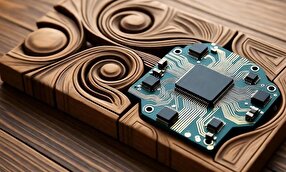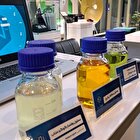Top News of Last Week with ANA

Azad News Agency (ANA) published a number of scientific and technological news during the past week whose top ones are as follows:
Iran to Inaugurate More Commercial Centers in Arab States
Director General of the Arab Asia Office of the Trade Development Organization (TPO) of Iran Abdol Amir Robeihavi announced plans to launch more commercial centers in the Arab countries.
“This year, the most pavilions of our country were held in international exhibitions in Turkey, Iraq, the UAE and Oman, and Iran was able to find new markets in these countries and showcase its industrial and production capabilities,” Robeihavi said.
He underlined the hike in acceptance of trade delegations in the West Asia Office, and stated, “The largest capacity for acceptance was from Turkey, Iraq and Oman. Delegations were also accepted from the UAE, Kuwait and Saudi Arabia.”
“This year, the ground for starting commercial activities with certain countries, including Saudi Arabia, has opened up, and in other words, our commercial relations with the country is in a new chapter; therefore, representatives of the private sector, in cooperation with the Iranian Chamber of Commerce, have established good relations with the Saudi companies,” Robeihavi said.
Over 150 Greenhouses in Iran Equipped with Nanobubble Technology
Over 150 greenhouses in Iran are equipped with nanobubble technology which can increase crop yields by 15%.
The area of hydroponic greenhouses in Iran is about 1,000 hectares. Equipping these greenhouses with nanobubble systems can increase crop yields by 15%, equivalent to creating 150 hectares of new greenhouses.
Exporting 80,000 tons of these products at an average price of $1.5 per kilogram brings in an income of about $120 million.
Also, in Iran, 500,000 tons of aquatic products are produced annually in 25,000 fish farms, and equipping these farms with nanobubble technology can double production to one million tons.
Iranian Scientists Use Agricultural Wastewater in Aquaculture
Researchers at the Aquaculture Reproduction and Breeding Research Center of the Islamic Azad University of Ahvaz in an innovative work used agricultural wastewater for breeding different fish.
“One of the effective techniques in managing the shortage of water resources is the use of closed-loop systems and water recirculation in the aquaculture system, which leads to maximum productivity of water resources,” Mojdeh Chellehmal Dezfoulnejad, the head of the Center, told ANA.
“In this breeding system, water quality management is highly important and requires advanced equipment to maintain water quality, which increases the initial cost of using a circulating system compared to open systems,” she added.
Chellehmal Dezfoulnejad explained that this increase in initial cost is economically justified given the scale of production in this system.
“Other methods include the aquaponics method as a new method in the production of agricultural products. In this method, fish farming wastewater is used in agriculture, and the plant grows with the nutrients present in the wastewater and chemical fertilizers are not used,” she noted.
Iranian Gov’t Eying Production of 30,000 MW of Solar Energy
Iranian Vice-President for Science, Technology and Knowledge-Based Economy Hossein Afshin underlined efforts to produce 30,000 MW of solar energy relying on domestic capability and indigenization and development of silicon chain technology.
At the first meeting of the Renewable Energy Council of Iran, which was held in the presence of the First Vice-President, the Head of the Environmental Protection Organization, and the Head of the National Standards Organization, Afshin presented a report on the prospects for solar energy in the next 10 years, the use of rooftop solar energy, the pursuit of the 30,000 MW target for solar energy in the 14th government, and indigenization and development of silicon chain technology.
Also, an official of the Renewable Energy and Electricity Efficiency Organization of Iran elaborated on the organization's activities, and announced a program for developing solar power production systems and chains in the industrial sector, establishing and expanding the capacity of solar energy-related manufacturing plants, supporting indigenization and domestic manufacturing in the Ministry of Energy, and signing memoranda of understanding with universities.
The head of Iran’s specialized training group of renewable energies and electricity efficiency announced last year that potentials existed in the country to supply materials needed for production of solar panels.
“Due to the existence of mines with a total capacity of 80 million tons of silicon materials across the country, Iran can become one of the key players in production of the main sources for making solar panels,” said Behrouz Dashti.
“Of course, in addition to silicon mines to build solar power plants, other main and important equipment like solar inverters, structures, cables, etc. are also needed and we need a lot of infrastructure that should be created and developed in the country over time,” he added.
Iranian Firms Producing Physical Vapor Deposition Nanocoating Devices
Several Iranian companies are active in the field of designing and manufacturing physical vapor deposition (PVD) nanocoating devices.
Yarnikan Saleh company is an Iranian firm which has developed vacuum coating systems (PVD) with the aim of meeting the needs of industrial and laboratory units in the country and has installed more than 100 devices in various industrial units so far.
Also, Fanavaran Nano Poushesh Jam company, with years of experience in the field of coating industrial parts using the PVD method and manufacturing related devices and equipment, is known as one of the largest knowledge-based firms in the field of nanocoating in Iran.
Meantime, Khala’ Poushan Felez company is another Iranian firm which manufactures various types of high-quality PVD vacuum coating devices.
Also, Fanavaran Sakht Ara company provides vacuum coating (PVD) services with features like exceptional hardness, high surface smoothness, and excellent corrosion resistance.
Iran Able to Produce 2.3 Million Tons of Chicken Meat Annually
According to the Iranian Ministry of Agriculture, the nominal capacity of chicken meat production in Iran is 2.3 million tons per year.
The ministry has also announced that Iran is among the top 10 countries in the world in establishing a chicken meat production line.
A memorandum was signed by the head of Iran’s Veterinary Organization and Gholam Ali Forouqi, the head of the Iranian Chicken Meat Chain Producers Association.
This cooperation is aimed at providing health supervision over various integrated chicken meat production chains, facilitating the production of safe and exportable products, and implementing international standards such as HACCP, GMP, and GHP.
The main objectives of the memorandum include complying with current country laws, creating a unified approach in administrative affairs, developing sustainable exports, and updating the national program to improve the health quality of chicken meat.
Iranian Specialists Upgrade 4G Network Infrastructure with Home-Made Product
Experts at an Iranian knowledge-based company succeeded in designing and producing a 4G cellular remote radio unit (RRU) which is used by the mobile operators to upgrade their 4G network infrastructure.
“The RRU product has been designed and produced by our company's specialists. This device, supporting various deployment and implementation scenarios, can fully meet the needs of the country's telecommunications network,” said Ali Akbar Tadayyon, the managing director of Farabin company.
“The 4G radio base station includes an RRU and a baseband system (BBU), and also has a management, operation and maintenance system that allows centralized management, configuration and software upgrades for operators,” he added.
Tadayyon explained that the RRU improves network coverage and capacity, specially in rural areas, adding, “This device is placed near the antenna and reduces costs by increasing signal quality and improving data transfer rates, as there is no longer a need to use low-loss cables to transmit radio signals.”
Iranian Knowledge-Based Firm Uses Indigenized 4G Technology Equipment in Yazd Province
Iranian researchers from a knowledge-based company installed and launched home-made 4G technology equipment in Yazd province in Central Iran.
“The equipment we built is to be used in other provinces in addition to the villages of Yazd province,” said Ali Akbar Tadayyon, the managing director of the knowledge-based company.
“In addition to providing increased access to information and online resources for learning, launching high-speed internet in villages will empower all types of businesses, increase their competitiveness in the provincial and national arena, develop new technologies like artificial intelligence and the Internet of Things, stimulate innovation to create creative and new businesses, and as a result improve the quality of life in these areas,” he added.
“High-speed internet also helps to provide new educational platforms, enable online courses and webinars, increase digital tourism capabilities, develop and improve the use of modern health services, and create new jobs,” Tadayyon said.
Iran Exports 13,000 Tons of Tea in 11 Months
Head of Iran's Tea Organization Habib Jahansaz announced that the country has exported 13,000 tons of Iranian tea worth $17 million in the past 11 months of the current Persian calendar year (to end on March 20).
“Iranian tea is a successful model in non-oil exports and 13,000 tons of Iranian tea worth $17 million have been exported in the past 11 months, Jahansaz said.
He added that the first destination for Iranian tea is Russia and the second country is India.
“Iranian tea has a unique position in the world due to the lack of use of agricultural pesticides and can compete with the rivals in the global markets,” Jahansaz said.
Iran Imports 277,000 Tons of Coated Steel Sheets in 1 Year
Iran imported over 277,000 tons of coated sheets, most of tin-plated, in the current Persian calendar year (to end on March 20), the Steel Producers Association announced.
Over 92% of the value of steel product imports is related to the import of steel sheets which is expected to be reduced by opening new projects and the production of special grades of hot rolled sheets next year, it added.
More than 40% of the value of steel product imports into the country (equivalent to $566 million) has been spent on the imports of cold rolled sheets, while about half of its production capacity is empty.
This volume of imports, which has grown significantly by 142% compared to the same period two year ago, has also caused a decrease in production of this product.
Iranian Scientists Use Machine Learning Technology for Flood Analysis
‘Flood Sensitivity and Vulnerability Analysis with Integrated Application of Remote Sensing Techniques, Machine Learning Algorithms, and Participatory Game Theory’ is the title of a project supported by the National Science Foundation of Iran.
“Given the increasing environmental degradation and the need to pay attention to new approaches to assess and monitor the condition of ecosystems, managing natural hazards like floods is necessary,” said Nasiri Khiavi, a PhD graduate in Watershed Science and Engineering from Tarbiat Modarres University.
“Flood sensitivity analysis is one of the most important elements of watershed systems or early warning strategies for preventing and reducing future flood conditions. Because it detects the most vulnerable areas based on physical conditions and determines their tendency to flood. Therefore, the term sensitivity can also be understood as one of the dimensions of flood vulnerability assessment,” he added.
“The results of preparing flood sensitivity and vulnerability maps using a combination of remote sensing techniques, machine learning algorithms, and collaborative game theory can be used by managers, researchers, planners, and even policymakers to identify critical areas and make optimal decisions in watershed science and engineering and water resources management. On the other hand, monitoring most algorithms and optimizing these methods and selecting the best method can save time and apply these methods in future studies,” Nasiri Khiavi said.
Iranian Company Makes LIBS Device for Analysis of Materials
An Iranian knowledge-based company has succeeded in production of a laser-induced breakdown spectroscopy (LIBS) device to analyze different materials with application in industries.
“The device is 100% indigenously manufactured and eliminating the time-consuming sampling process (from several days to several minutes) is one of the features of this device,” Abouzar Heydarzadeh, the managing director of the knowledge-based company, told ANA.
“Analysis of minerals, agriculture, food and metals (like gold and sponge iron) are among the applications of the device,” he added, noting that the device is extraordinary accurate.
“Selling 8 devices in Iran and receiving requests from the UAE, Azerbaijan and Afghanistan have been among the measures adopted to develop the sales of our product,” Heydarzadeh said.
Iran Standing among Most Advanced Centrifuge Manufacturers in World
An Iranian knowledge-based company succeeded in production of different types of centrifuges and exported them to several world states, including the European countries.
“So far, over 90 devices manufactured by our company have been installed and put into operation across Iran in various industries and are receiving services,” said Ali Qorbani, the commercial manager of the knowledge-based company.
“These devices can separate two heterogeneous phases by creating very high centrifugal force, which is applicable from the pharmaceutical and biotechnology industries to the chemical, food and mineral industries,” he added.
At the last exhibition in Germany, we unveiled our centrifuges for the first time in the European Union, which was well received,” Qorbani said.
Iran-Made Multifunctional Ventilator Capable of Monitoring Vital Signs
An Iranian inventor and medical equipment expert successfully designed and produced a multifunctional ventilator that can perform artificial coughing, suctioning, and monitoring vital signs simultaneously.
“The advantage of a multifunctional ventilator is that it has both suction and cough assistance capabilities, while the foreign models only have the advantage of cough assistance, meaning that apart from that, they must also have a suction device to be able to remove the patient's secretions,” Mahsa Gohar Ara, a master of science in Medical Engineering at the Islamic Azad University’s Khomeini Shahr branch, told ANA.
“Of course, this capability can also be added to the ventilator, as foreign devices must cut off oxygen from the patient when they want to work in an invasive manner (tracheostomy) or intubation. A patient who is connected to a ventilator may have a problem using this device, so our device enjoys the capability to provide oxygen without having to cut off oxygen from the patient,” she added.
Gohar Ara explained that a cough assist device has a positive pressure, like an inspiratory simulator, which is put into the patient's lungs and reduces this pressure to zero for a very short period of time, and then a rapid negative pressure is applied, and this negative pressure is quickly exhaled, causing secretions to be directed towards the patient's airway, and then evacuated using suction.
4155/v





















